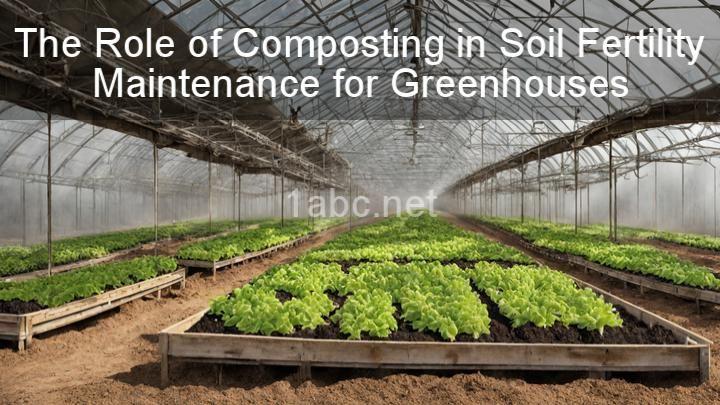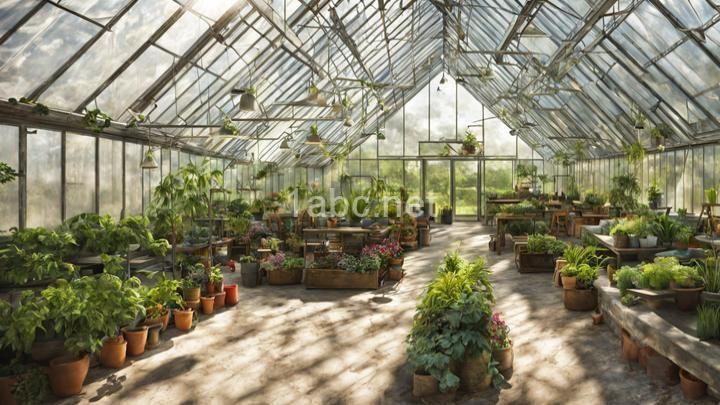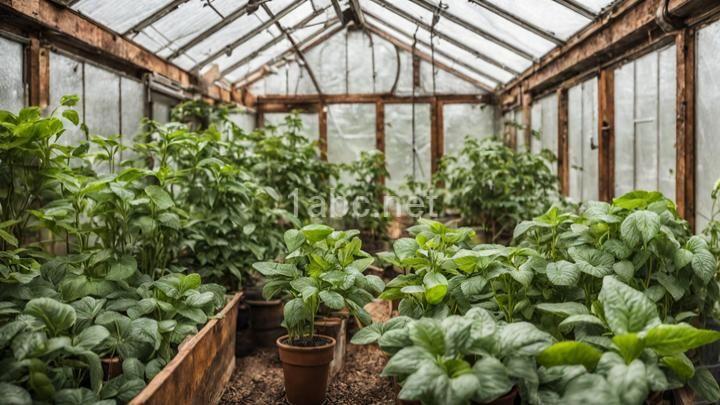The Role of Composting in Soil Fertility Maintenance for Greenhouses
Introduction:
Section 1: Understanding Soil Fertility
Section 2: Benefits of Composting in Greenhouse Gardening
Section 3: Composting Techniques for Greenhouse Gardens
Section 4: Applying Compost to Maintain Soil Fertility in Greenhouses
Section 5: Other Considerations for Successful Composting in Greenhouses
Conclusion:

Introduction:
Welcome readers to the blog post! Greenhouse gardening is a fantastic way to grow a wide variety of plants and enjoy fresh produce all year round. However, one of the challenges that greenhouse gardeners face is maintaining soil fertility for optimal plant growth. In this blog post, we will explore the importance of soil fertility in greenhouse gardening and how composting can play a crucial role in achieving this goal.
Section 1: Understanding Soil Fertility
To begin, let's define what soil fertility is and why it matters for greenhouse gardening. Soil fertility refers to the ability of the soil to provide the necessary nutrients and conditions for plants to grow and thrive. Healthy soil fertility is essential for strong root development, disease resistance, and high-yielding crops.
There are several key nutrients required for healthy plant growth, including nitrogen, phosphorus, and potassium. These nutrients, also known as macronutrients, are essential for various plant functions such as photosynthesis, root development, and flower and fruit production. In addition to macronutrients, plants also require micronutrients like iron, zinc, and manganese in smaller quantities.
However, over time, continuous cultivation in greenhouses can deplete soil fertility. The constant uptake of nutrients by plants without replenishing them can lead to nutrient deficiencies, poor plant growth, and reduced crop yields. That's where composting comes in!
Section 2: Benefits of Composting in Greenhouse Gardening
Composting is a sustainable practice that offers numerous advantages for greenhouse gardening. By recycling organic waste, composting reduces the need for synthetic fertilizers and helps gardeners create their own nutrient-rich soil amendment.
One of the primary benefits of composting is its ability to improve soil structure. Compost contains organic matter that helps to bind soil particles together, creating a crumbly texture that allows for better root penetration and water movement. This improved soil structure also enhances drainage, preventing waterlogged roots and the risk of root diseases.
Compost is also excellent at retaining moisture in the soil. The organic matter in compost acts like a sponge, holding onto water and releasing it slowly to plant roots. This can be particularly beneficial in greenhouse gardening, where maintaining consistent moisture levels is crucial for plant health.
Furthermore, compost is a natural source of essential nutrients. As organic matter breaks down during the composting process, nutrients are released into the soil, providing a slow and steady supply to plants. This natural release of nutrients reduces the risk of nutrient leaching and ensures a constant supply of macronutrients and micronutrients for healthy plant growth.
Section 3: Composting Techniques for Greenhouse Gardens
Now that we understand the benefits of composting, let's explore how to start a compost pile or bin in your greenhouse garden. Composting is a simple yet effective process that can be tailored to suit your available space and resources.
To begin, gather organic materials suitable for composting. These can include kitchen scraps like fruit and vegetable peels, coffee grounds, and eggshells. Yard waste such as grass clippings, leaves, and pruned branches can also be added. It's important to avoid adding meat, dairy products, and oily foods, as they can attract pests and slow down the decomposition process.
The ideal compost pile or bin should have a good mix of carbon-rich materials (often referred to as "browns") and nitrogen-rich materials (known as "greens"). Browns include items like dried leaves, straw, and shredded newspaper, while greens consist of fresh grass clippings, kitchen scraps, and plant trimmings. Aim for a carbon-to-nitrogen ratio of roughly 25:1 to facilitate efficient decomposition.
To start composting, layer your organic materials in the compost pile or bin. Make sure to turn the pile occasionally to aerate it and speed up the decomposition process. Keep the compost moist but not waterlogged, as excessive moisture can lead to unpleasant odors and slow down decomposition. Within a few months, you will have rich, dark compost ready to be used in your greenhouse beds or containers.
Section 4: Applying Compost to Maintain Soil Fertility in Greenhouses
Once your compost is ready, it's time to apply it to your greenhouse beds or containers to maintain soil fertility. Ideally, incorporate compost into your soil before planting or as a top-dressing during the growing season.
Before planting, spread a layer of compost over the greenhouse beds and mix it into the top few inches of soil. This will ensure that the nutrients from the compost are readily available to plants as they grow. If you're using containers, mix compost into your potting mix, replacing a portion of it with compost to provide an extra nutrient boost.
When applying compost as a top-dressing during the growing season, spread a thin layer of compost around the base of plants, taking care not to cover the stems. Lightly rake the compost into the top layer of soil, allowing the nutrients to gradually release to the plant roots.
In addition to adding compost, it's crucial to monitor nutrient levels regularly. Conduct soil tests to determine any nutrient deficiencies and adjust your composting and fertilization practices accordingly. Remember, compost is a slow-release fertilizer, so it's essential to keep track of nutrient levels to ensure your plants receive the necessary nutrients throughout their growth cycle.
Section 5: Other Considerations for Successful Composting in Greenhouses
While composting is generally a straightforward process, gardeners may encounter challenges or issues along the way. Let's address some common concerns and provide eco-friendly solutions.
One common challenge is the odor that can arise from compost piles. This is often a result of improper composting techniques or an imbalance of materials. To combat odor, ensure a proper mix of browns and greens, turn the compost regularly to promote aeration, and avoid adding materials that are prone to producing strong odors, such as meat or dairy products.
Pests can also be a nuisance in compost piles. To deter pests, avoid adding food waste that attracts them, and cover the compost pile with a layer of leaves or straw to discourage pests from making a home in your compost.
If you encounter any issues with your composting process, don't be discouraged. Troubleshooting is part of the learning journey. Reach out to fellow gardeners, join online communities, or consult gardening resources for guidance and advice. Sharing your experiences and tips in the comments section of this blog post can also help others facing similar challenges.
Conclusion:
Maintaining soil fertility is of utmost importance for successful greenhouse gardening. Composting offers a sustainable and effective solution to replenish nutrients naturally, improve soil structure, and retain moisture. By following the steps outlined in this blog post, you can create your own nutrient-rich compost and apply it to your greenhouse beds or containers to promote healthy plant growth.
Remember, composting is not only beneficial for your garden but also for the environment. By reducing waste and recycling organic materials, you are contributing to a more sustainable future. So, let's get composting and enjoy the benefits of healthy soil and thriving greenhouse gardens!
If you have any questions or would like to share your own composting experiences, please feel free to leave a comment below. Happy composting!
FREQUENTLY ASKED QUESTIONS
What is composting?
Composting is the process of recycling organic materials, such as food scraps, yard waste, and other biodegradable materials, into nutrient-rich soil. This process involves the decomposition of these materials by microorganisms, including bacteria, fungi, and earthworms, which break down the organic matter into a dark, crumbly substance known as compost. Composting is an environmentally-friendly practice that not only helps reduce waste sent to landfills but also produces a valuable soil amendment that can be used to improve soil health, retain moisture, and nourish plants.
How does composting improve soil fertility?
Composting improves soil fertility in several ways:
- Nutrient enrichment: Compost is rich in essential nutrients, such as nitrogen, phosphorus, and potassium, which are essential for plant growth. When compost is added to soil, these nutrients are slowly released over time, providing a steady supply of nourishment for plants.
- Organic matter addition: Compost is an excellent source of organic matter, which improves soil structure and moisture-holding capacity. Organic matter helps create a porous soil structure, allowing roots to penetrate easily and access nutrients and water more effectively.
- Microbial activity promotion: Compost contains a diverse community of beneficial microorganisms, including bacteria, fungi, and earthworms. These microorganisms help break down organic matter, release nutrients, and enhance soil biology. They also help suppress harmful pathogens and diseases.
- pH regulation: Compost has the ability to regulate soil pH by buffering against extreme fluctuations. This helps maintain an optimal pH range for nutrient availability and microbial activity, which ultimately supports healthy plant growth.
Overall, composting is a natural and sustainable way to enhance soil fertility by enriching it with essential nutrients, improving its structure, promoting beneficial microbial activity, and regulating pH levels.
What are the benefits of using compost in greenhouse soil?
Using compost in greenhouse soil offers several benefits:
- Nutrient-rich soil: Compost enhances the fertility of the soil by providing a rich source of organic matter and essential nutrients. The decomposed organic material in compost releases nutrients slowly, promoting healthier plant growth.
- Improved soil structure: Compost improves the physical properties of soil, such as texture, water-holding capacity, and drainage. It helps in breaking up compacted soil and enhances aeration, which allows plant roots to penetrate easily and access necessary air and water.
- Nutrient retention: Compost acts as a sponge, holding onto essential nutrients and preventing them from being washed away by irrigation or heavy rainfall. This helps in reducing the need for additional fertilizers, saving costs and minimizing nutrient runoff.
- Enhanced disease resistance: Compost contains beneficial microorganisms that can suppress harmful pathogens, which can help reduce the incidence of soil-borne diseases. This is especially important in greenhouse environments where diseases can easily spread.
- Environmental sustainability: By utilizing compost, you contribute to waste reduction and recycling. Composting organic materials diverts them from landfills, reducing greenhouse gas emissions and promoting a more sustainable approach to gardening and agriculture.
Overall, incorporating compost into greenhouse soil improves its overall fertility, structure, and disease resistance while supporting a sustainable and environmentally friendly growing system.
Can composting be done in a greenhouse setting?
Yes, composting can be done in a greenhouse setting. Greenhouses provide a controlled environment that can help accelerate the decomposition process and maintain optimal conditions for composting. However, it is important to manage the compost pile carefully to ensure proper aeration, moisture levels, and proportionate mix of green and brown materials. Additionally, the use of odour control methods like covering the compost pile can prevent unpleasant smells from spreading inside the greenhouse.

